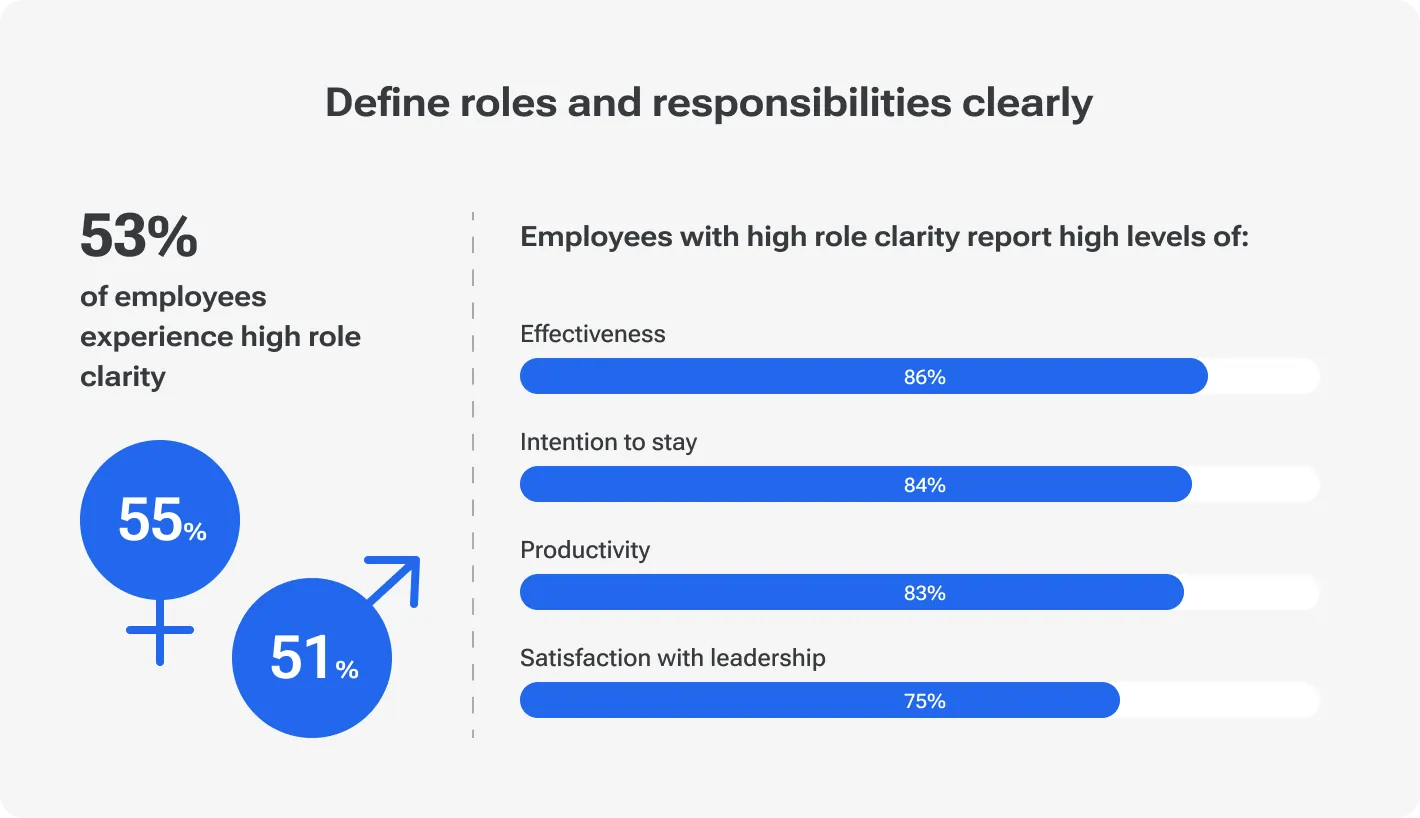More than 76% of businesses are outsourcing important tasks like coding, quality assurance and 80% of company leaders plan to keep or increase outsourcing investments.
While outsourcing delivers cost savings, efficiency gains, and specialized expertise, success hinges on proper integration. After all, 74% of business transformations fail because of poor communication and integration processes.
By introducing staff augmentation services with clear communication, businesses can build a solid team that consistently delivers results and maximizes your outsourcing investment
Flexible staff augmentation and expertise transitioning services
The foundation for integrating outsourced developers into in-house teams
Integrating outsourced developers into your in-house team is like bringing new players into a sports team. To succeed, everyone needs to work together smoothly.
Let’s explore key steps to build a strong foundation for this integration.
Ruin the myth of the “Us vs. Them”
People often sort individuals into groups. It isn't a necessary negative, but it becomes problematic when used to exclude others, even unintentionally.
Your in-house employees could perceive outsourced engineers as "opponents", which leads to the belief that one group is superior and the "other" group is the source of issues.
This mindset creates a divide between in-house teams and outsourced teams, making it hard for everyone to work together, leading to misunderstandings and missed opportunities.
To build a truly cohesive team, prioritize inclusivity from the beginning. Everyone should feel valued and part of the same team, regardless of their physical location or employment arrangement.
Best everyday strategies to integrate outsourced developers in your in-house team:
Encourage open dialogue
Establish shared communication platforms like Slack or Teams with dedicated channels for work discussions, problem-solving, and casual conversation. Make these spaces accessible to all team members on equal terms and actively invite input from everyone, regardless of location.
Emphasize common goals
Make sure the entire team knows the main goals of the project. For example, you could have a kickoff meeting where everyone discusses what they hope to achieve. Use visuals like a project timeline or a shared goal board, so everyone can see how their work contributes to the bigger picture.
Foster team connections
Implement a buddy system pairing in-house and outsourced developers for collaboration on smaller projects, creating natural opportunities for knowledge sharing and relationship building.
Lead by example
Demonstrate inclusive leadership at all levels. Ensure managers give equal consideration to ideas from all team members and distribute meaningful work equitably. Publicly recognize contributions from both in-house and outsourced developers, reinforcing that success belongs to the entire unified team.
When team members feel included and connected, they are more likely to collaborate effectively and achieve great results together.
Define clear objectives and expectations
Clear expectations between in-house and outsourced teams aren't just nice to have – they're essential for avoiding costly misunderstandings. When both sides understand exactly what's required, projects stay on track and deadlines are met.
When company hires dedicated software development team,it implements this structured approach:
Initial discussions: Hold comprehensive kick-off meetings focusing on specific project priorities, concrete timelines, and quantifiable success metrics. Address potential obstacles proactively.
Joint documentation: Develop a detailed shared document outlining exact goals, specific deadlines, and individual responsibilities accessible to all team members.
Regular review meetings: Conduct focused weekly or bi-weekly evaluations measuring progress against established goals, celebrating completed milestones, addressing specific challenges, and adjusting timelines as needed.
Feedback loops: Establish specific channels for constructive feedback from both teams. For example, enable your fintech team to request targeted refinements to features during scheduled check-ins.
This methodical approach creates mutual accountability and a shared vision and understanding, ultimately leading to a successful project outcome.
10 questions to ask your software development outsourcing vendor
Select the right partner
The right partner can enhance productivity, bring in specialized skills, and help achieve business goals more effectively. When evaluating potential outsourcing partner, focus on these critical factors:
Technical expertise: Assess candidates' demonstrable skills in your required technologies. Review their portfolio for similar projects and request client references to verify their proficiency with your specific tech stack.
Domain knowledge: Test their understanding of your industry's regulations, compliance requirements, and user experience standards. Ask detailed questions about how they've handled similar challenges in previous projects.
Cultural compatibility: Evaluate how their team values and work style complement yours. Schedule team interactions to gauge communication dynamics before finalizing any agreement.
Communication protocols: Examine their communication practices, including response times, documentation methods, and meeting structures. Request examples of how they've handled project communications during critical phases.
Adaptability: Verify their capacity to adjust to changing requirements through examples of how they've pivoted during previous projects. This flexibility is particularly crucial in dynamic sectors like fintech.
Quality assurance: Investigate their quality control processes, testing methodologies, and error resolution procedures. Request specific metrics from past projects that demonstrate their commitment to excellence.
The partner selection process extends beyond technical capabilities to ensuring their development approach aligns with your team's needs and working style. A strategic partnership provides collaborative problem-solving rather than just service delivery.
Onboard and introduce
Research shows 91% of new hires who receive effective cultural orientation feel connected to their workplace, compared to only 29% who experience inadequate onboarding.
To integrate outsourced developers implement these specific strategies:
Initial cultural immersion. Dive deep into your company’s mission, values, and vision. This can stimulate engagement and connection from the outset.
Structured team introductions. Facilitate informal meet-and-greet sessions where outsourced developers can interact with their in-house counterparts. This clarifies expectations and helps new team members understand team dynamics.
Clear project overviews. Involve both outsourced and in-house teams for kick-off meetings. This ensures everyone is aligned on goals, responsibilities, and timelines while reinforcing the collaborative nature of your work culture.
Access to resources and tools. Create a centralized toolkit that includes access to vital resources like employee handbooks, process documentation, and communication protocols.
Building bridges: Fostering collaboration
Agile software outsourcing allows companies to leverage specialized skills and resources without the need for extensive internal teams. However, success in agile software development outsourcing goes beyond just hiring external experts, it requires effective collaboration between in-house teams and outsourced developers.
Fostering collaboration is vital for creating seamless workflows and achieving project goals. This connection ensures that everyone is aligned, communicates openly, and can adapt quickly to changes, which is a cornerstone of agile methodology.
Establish communication channels and cadence
Miscommunication is a silent revenue killer, costing U.S. businesses an estimated $1.2 trillion annually. Factors such as non-verbal communication missteps, information overload, and translation issues contribute significantly to negative workplace communication outcomes. In fact, a staggering 86% of employees cite ineffective communication and poor internal communication skills as the root cause of workplace failures.
Conversely, workplaces that implement effective communication strategies enjoy 4.5 times higher employee retention, leading to significant savings on recruitment costs and fostering improved team spirit.
Furthermore, employees who experience transparent business communication report 12 times higher job satisfaction compared to those in environments with poor communication practices. This highlights the role of effective communication as a morale booster!
Research shows that teams that communicate effectively can see an increase in employee productivity of up to 25%. This is beneficial not only for the company but also for individual career advancement.
Thus, setting up effective communication tools and establishing a regular meeting cadence is crucial for ensuring alignment and maintaining a smooth workflow within teams, to achieve it, you can do the following:
Choose the right tools: Slack or Microsoft Teams facilitate instant messaging and group chats, making it easy for team members to communicate in real-time. Zoom or Google Meet for face-to-face meetings, which help enhance clarity and strengthen relationships.
Establish regular meeting cadence: For agile teams, short daily stand-up meetings help synchronize activities and address any roadblocks. This promotes accountability and keeps everyone focused on their immediate goals.
Set clear guidelines and expectations: Establish clear guidelines on when and how to use different communication tools. For example, use instant messaging for quick questions while reserving emails.
Why is in-house development holding you back?
Define roles and responsibilities clearly
Having clear roles and responsibilities is essential for a successful team.
Research shows that employees who understand their roles are 53% more efficient and 27% more effective at work compared to those who do not. Overall, work performance improves by 25% when everyone knows their specific responsibilities.
For both in-house and outsourced developers, defining roles can prevent overlap and confusion. When each person knows their duties, it is easier to track progress and identify any issues. If problems arise, it’s clear who should address them, which keeps projects moving forward efficiently.
Overall, taking the time to define roles and responsibilities helps create a more organized and productive work environment.
Promote teamwork and collaboration
The cost of poor collaboration is measurable, and it’s staggering. Businesses in the U.S. alone waste an estimated $37 billion annually on unproductive meetings. Studies indicate that 64% of employees waste at least three hours a week due to inefficiencies in collaboration, and 20% lose up to six hours. Collaboration drag is a widespread issue, particularly in larger teams and organizations.
According to a survey, nearly 71% of employees consider meetings unproductive, impacting their ability to focus on critical tasks. IT professionals as many other workers can experience these issues.
These challenges hinder the company’s ability to meet revenue goals, emphasizing the direct link between collaboration inefficiencies and overall business performance.
Fortunately, C-level officers can reduce collaboration drag by up to 23% through targeted skill-building initiatives and strategic talent investments.
And they actually should do that, as the Deloitte study found that 73% of employees who engage in collaborative work report improved performance, while 60% say it sparks their innovation. This demonstrates that teamwork and collaboration play a vital role in achieving both individual and team success.
By implementing these strategies, organizations can enhance teamwork and reduce collaboration drag, leading to improved performance and greater job satisfaction for employees.
Address cultural differences
Respecting cultural differences is essential for successful teamwork, especially in remote settings. A survey of employees from 90 countries revealed that 89% of remote teams had members from at least two different cultures, with more than a third representing four or more cultures.
Among these employees, 78% identified open discussions about problems as a key cultural challenge. For example, the word “no” can have entirely unique meanings: for some, it might feel confrontational, while for others, it’s just a straightforward answer.
Yet, you should be opting for a diverse team, as the research from McKinsey & Company shows that companies with a diverse workforce are 35% more likely to outperform their competitors. Imagine a mid-sized tech company moving into Europe. By building a team with different cultural backgrounds, they can better understand local clients and make informed decisions.
A recent survey found that 70% of consumers are more likely to support brands that show cultural awareness, highlighting the need for businesses to align their strategies with local values and beliefs.
Manage performance and ensure success
Organizations must not only set clear goals and expectations but also create an environment that fosters accountability and continuous improvement. By aligning individual and team objectives with the overall business strategy, companies can ensure that everyone is working towards a common purpose.
This section will explore key strategies for managing performance effectively, highlighting the importance of clear communication, goal-setting, and resource allocation to drive results and ensure long-term success for both individuals and the organization as a whole.
Set measurable goals and KPIs
A study of over 11,000 companies showed that businesses with plans grow faster than those without. When companies write down their goals, they tend to see 30% growth in sales.
Moreover, 50% of workers believe that having clear goals makes them more motivated and gives them a sense of purpose in their work. For instance, when employees use OKRs (Objectives and Key Results), 60% of them have a good understanding of the company’s strategy. However, in companies that don’t use OKRs, only about 37% understand the strategy well.
Setting measurable performance goals and KPIs helps ensure accountability and success in projects with outsourced developers. These tools allow everyone to see what is expected and track progress. Here are some examples of useful KPIs for outsourced developers:
Project completion rate: The percentage of tasks completed on time.
Code quality: This can be measured by the number of bugs or issues found after deployment.
Response time: How quickly developers address and resolve issues or requests.
Task efficiency: The amount of time taken to complete specific tasks compared to the estimated time.
User satisfaction: Feedback from users about the performance and usability of the developed software.
With clear and measurable goals and KPIs, businesses can better manage outsourced developers, ensuring that everyone is on the same page and striving for success.
Provide regular feedback and recognition
Providing regular feedback and recognition is essential for keeping employees motivated and engaged. According to Gallup, 80% of employees who receive meaningful feedback in the past week feel fully engaged in their work. This highlights the importance of maintaining open communication and recognizing hard work.
When employees receive regular feedback, they know what is expected and where they stand. This clarity helps them focus on their tasks and encourages them to improve.
Additionally, recognizing accomplishments fosters a positive work environment where employees feel valued and appreciated, leading to higher job satisfaction and better performance overall.
By nurturing a culture of feedback and recognition, businesses can create a motivated workforce ready to contribute to the company's success.
Address challenges and conflicts
When working with in-house and outsourced teams, various challenges and conflicts can arise. Understanding these issues is the first step toward resolving them effectively:
Challenge
Reasons that drive the situation
Solution
Misunderstandings due to different time zones, languages, or cultures.
Encourage open communication through regular check-ins, video calls, and chat groups.
Different goals or priorities causing confusion about project direction.
Set clear goals and expectations for both teams from the beginning.
Inconsistent quality of work between in-house and outsourced teams.
Implement clear quality standards and provide training or guidelines to ensure alignment.
Difficulty in building trust due to lack of interaction between teams.
Organize team-building activities to foster relationships and enhance trust.
Differences in work culture and practices leading to misunderstandings.
Promote cultural awareness and sensitivity training to enhance understanding between teams.
Delays in feedback or decision-making can slow down progress.
Establish protocols for timely feedback and encourage prompt responses to queries.
Inconsistent tools or platforms can hinder collaboration.
Standardize tools and platforms used by both teams to ensure smooth collaboration.
Difficulty in tracking progress and performance across teams.
Use project management tools to monitor progress and set performance metrics for both teams.
Open communication and a focus on problem-solving will help build a stronger partnership, leading to better results for the organization.
Continuous improvement: Iterating and optimizing
Product excellence is a constant journey rather than a final destination. Continuous improvement refers to the ongoing effort to enhance products, services, processes, and team collaboration. By focusing on iterative cycles of feedback, evaluation, and refinement, organizations can foster innovation and adapt to changing market demands.
This approach not only helps in identifying areas for improvement but also empowers teams to experiment and implement solutions that drive efficiency and effectiveness. In this section, we will explore key strategies for continuous improvement, emphasizing the importance of creating a culture that embraces change and values ongoing learning.
Regular retrospectives
Retrospectives are regular meetings where team members come together to discuss what worked well, what didn’t, and how they can improve moving forward.
They are especially valuable during the integration process when different teams or systems need to work together smoothly. By holding retrospectives, teams can pinpoint specific areas that need attention and develop actionable plans for improvement.
The best retrospectives tend to last between 30 and 45 minutes. Research strongly suggests that teams give a high score – around 8.5 out of 10 – when retrospectives are kept within this time frame.
However, there's not much difference if the meeting goes a bit longer, like 46 to 60 minutes, which still receives an impressive score of 8.47 out of 10.
This suggests that while it’s important to keep retrospectives concise enough to maintain focus, there is also value in allowing just a little extra time for more profound discussions if needed. The key is to create an open and engaging environment where all team members feel comfortable sharing their thoughts.
This way, you can make the most of these meetings and continually improve the integration process, leading to better outcomes in the future.
Adapting and evolving
As teams grow and projects change, it’s essential to remain flexible and adapt the integration approach to meet new needs. What works for a small team at the start of a project may not be effective as the team expands or as the project requirements evolve. Being open to adjustments can lead to better collaboration and improved results.
At some point, daily meetings could become overwhelming and unproductive. Instead of sticking to the old routine, the team decides to transition to bi-weekly meetings and uses a shared online tool for daily updates. This change allows everyone to stay informed while giving them more time to focus on their tasks.
Remaining flexible also means being open to feedback and willing to make changes when necessary. By being willing to change based on the team’s growth and project requirements, teams can create a more effective and responsive approach that better meets their goals. This flexibility enhances productivity and fosters a culture of continuous improvement, where everyone feels empowered to contribute to the team’s success.
Conclusion
Fostering a unified team is essential for achieving long-term success, especially when combining the strengths of both in-house and outsourced developers.
A cohesive team can leverage diverse skills, perspectives, and experiences, ultimately leading to better problem-solving and innovation.
When in-house and outsourced developers work together seamlessly, they can achieve goals more efficiently and create products or solutions that truly resonate with users.
If you’re looking to strengthen your teams and drive your projects forward, consider partnering with specialists who can provide the expertise you need.
Contact Devico for outsourcing and staff augmentation services that can help you build a unified team tailored to your specific requirements.
End-to-end solutions with predictable budgets, a time-to-market advantage with up to 50% budget savings




